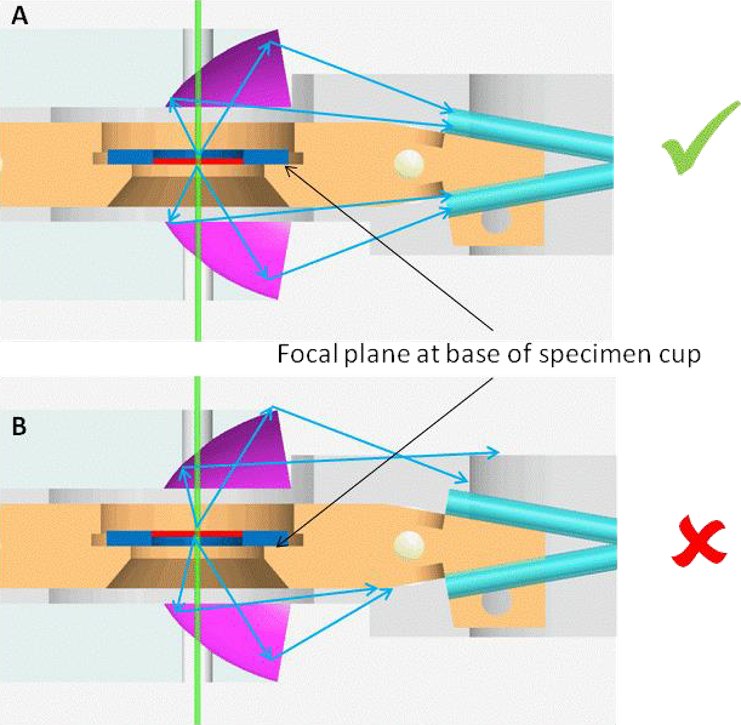Alignment
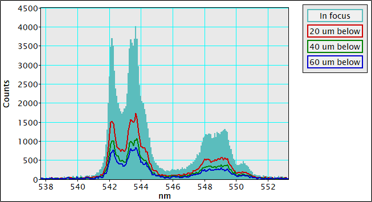
Anyone who has used an electron microscope or looked down an optical microscope realizes the ability to align and focus the (electron) optical system is critical to achieving the sharpest images. Cathodoluminescence (CL) microscopy experiments use both the electron optics of the scanning (transmission) electron microscope (SEM or STEM) and the light optics of the CL detector, and each must be aligned well. The two optical systems and samples must be co-aligned precisely to collect the sharpest CL maps, spectra, and emission patterns. As seen in the example spectrum (collected with the Monarc® system), misalignment of as few as tens of microns in a single axis significantly reduces performance. In other CL systems, a misalignment of just a few micrometers can prevent meaningful data from being collected.
In the following section, learn why optical alignments are so important and how to adjust a system to capture the best results. The system includes independent methods for Monarc users that automatically perform the alignment step without user input. The following section is useful for developing understanding, but proceed to the Monarc system's instructions for the practicalities of collecting optimized results.
SEM
The electron beam generates light within our sample, e.g., within the interaction volume. In many specimens, these photons radiate isotropically, e.g., propagate with equal intensity in all directions. It may help to visualize this process by considering the light emission as a point source located at the center of the globe that radiates such that there is equal illumination at all points on the surface of the globe:
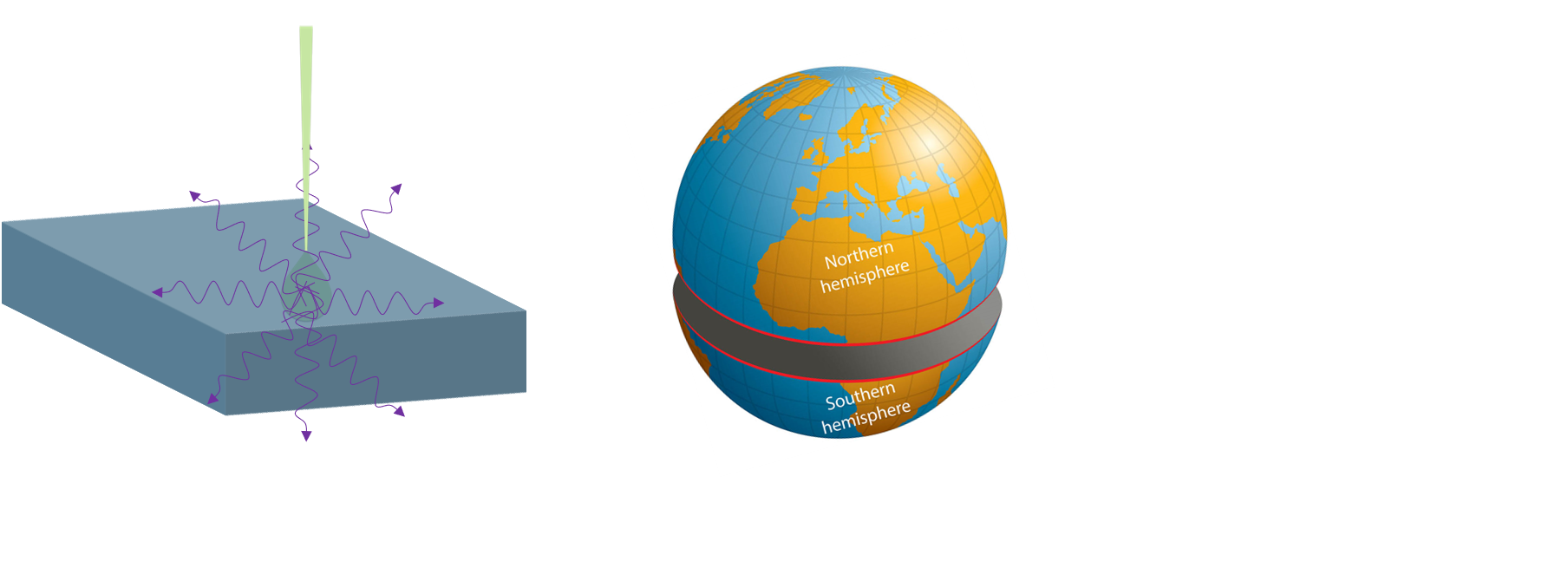
In some cases, the sample may absorb light before it ever escapes the specimen before it reflects and refracts at the sample's surface and is absorbed by the electron microscope stage or holder. For these reasons, in bulk specimens, it is more typical to consider that photons are emitted from the sample surface into the upper hemisphere only:

To have a detector with high sensitivity, it is of utmost importance to maximize the collection of photons. The preferred method is to use a high–NA (numerical aperture) collection mirror. A typical collection mirror is an off-axis paraboloid with an aperture to allow the electron beam to reach the specimen. When the sample is located at the parabola's focal point, ~85% of the emitted photons are collected and reflected into a collimated beam for further processing by an optical system. The polar plot of the Northern Hemisphere below illustrates the solid angle covered by a typical collection mirror:
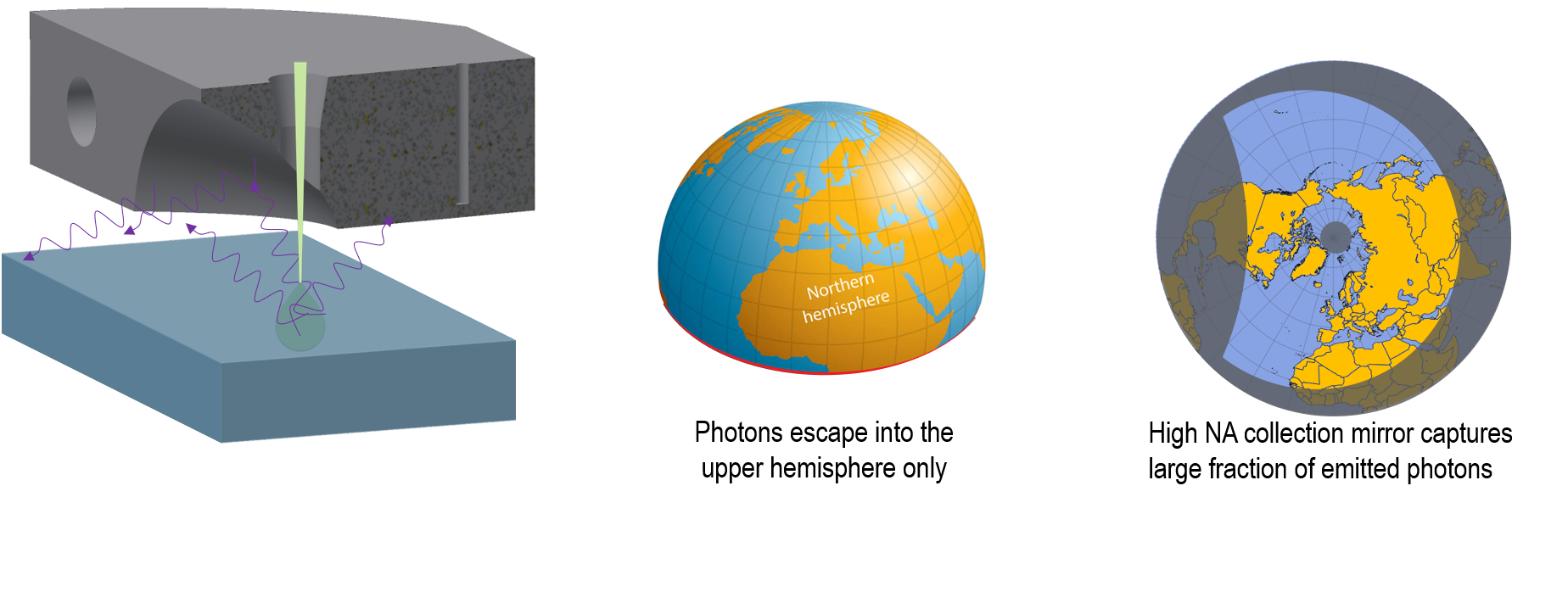
In these high-sensitivity systems, optical alignment becomes critical to capturing sharp maps, high-resolution spectra, and emission patterns. See, for example, comparative CL maps and a collection of spectra captured with varying degrees of misalignment in (just) one axis below:
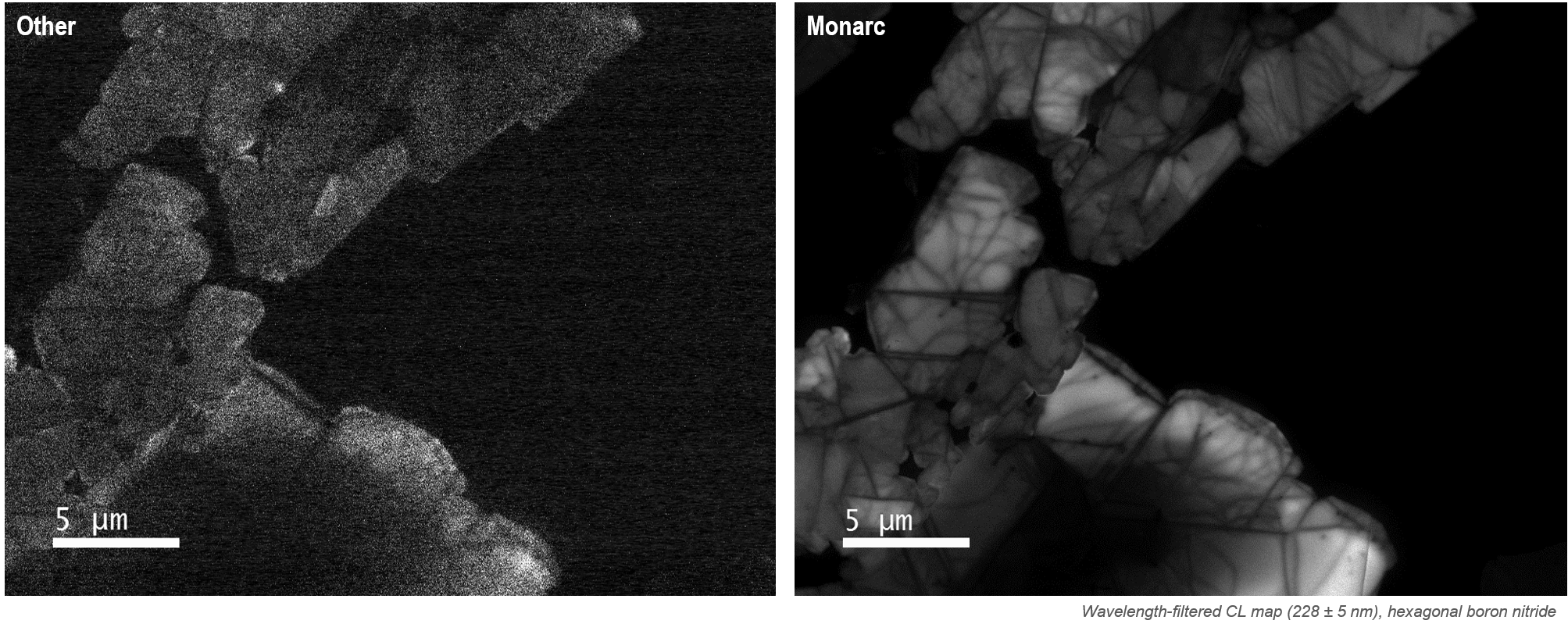
In these unfiltered CL maps of hexagonal boron nitride, a misalignment of 100 μm (in the Z-axis) reduces the signal-to-noise ratio by a factor of 10, but with poor alignment in more than one axis, this could easily be a factor over 1000.
In the example of a CL spectrum shown at the top of the page, a 20 μm misalignment in the Z-axis reduces the collected signal by 50%, and at a misalignment of 60 μm, you can no longer resolve the double peak at 543 nm. In some analysis systems, a misalignment of just 5 μm may prevent data collection.
Basic alignment workflow
The basic steps to begin using a high-performance, mirror-based CL system appear to be straightforward:
-
Insert the collection mirror.
-
Center the collection mirror.
-
Set the sample at the operating working distance.
-
Focus on the SEM image.
-
Start your experiment.
We have already seen that it is important to align the SEM, CL system, and sample to within only a few micrometers. This sounds challenging enough, even before considering that you cannot directly observe the focal point of the collection mirror. The collection mirror of a CL system is designed with an aperture to allow the electron beam to reach the sample. Thus, the CL mirror's focal point is approximately at the center of the aperture. However, the exact location depends not only on the accuracy of the mirror itself but also on the alignment of the SEM's electron beam. When the SEM's accelerating voltage changes, the electron beam axis can shift, causing an apparent translation to the mirror's position and, if the optical axis of the SEM is not perpendicular, an apparent shift in the position of the focal point within the aperture.
With a specimen that emits light strongly and uniformly over hundreds of microns, performing this alignment manually after good operator training is relatively straightforward. Most, if not all, samples of interest for CL measurements exhibit significant spatial variation that makes this challenging or impossible even for expert users on many specimens.
Monarc MonoCL™/ChromaCL™ Vulcan®
Schematic ray diagram
As we have seen, optical alignment is critical to collect optimal results (sharpest images or spectra or during the shortest acquisition time). In the following section, a simplified ray-trace diagram helps explain why alignment is so critical to many of the basic modes of operation of a CL system. One consequence of employing a collection mirror is that the alignment of the sample, the electron beam of the SEM, and the CL system becomes very important. Consider the simplified schematic of a CL detector shown below:
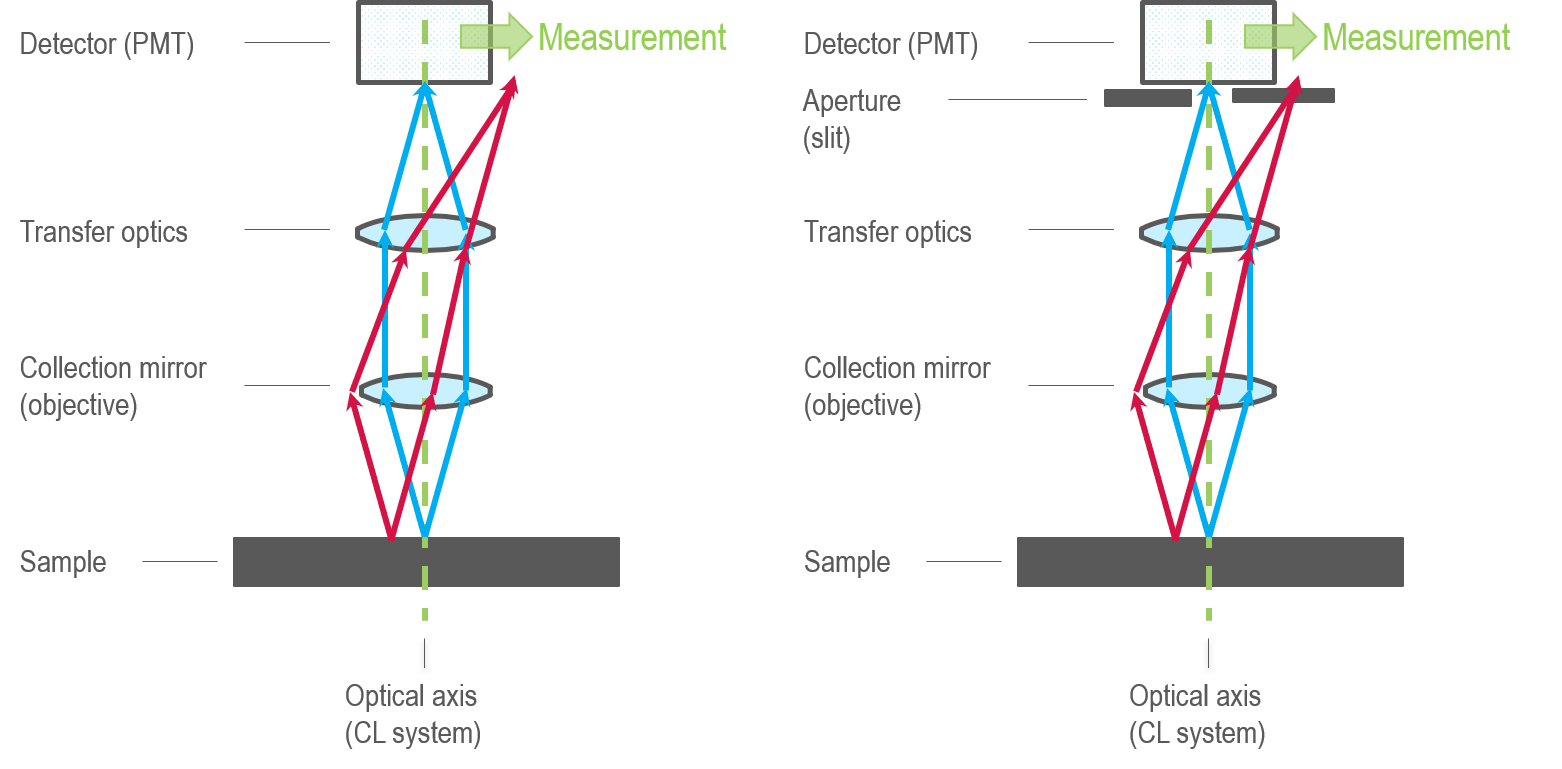
One can assume that light emerges from the sample at the location of the electron beam. If the sample and CL system are aligned well (blue lines), the light reflects from the collection mirror in a collimated ray bundle. For instance, the light rays travel parallel to transfer optics (a generalized term for the lenses, mirrors, or optical fibers used in the optical design). This transforms the ray bundle into a format suitable for the downstream analysis hardware. If the two systems are not aligned well around the CL system's focal point (red lines), the ray bundle no longer travels through the optical system in the intended manner, and few photons reach the downstream analysis hardware. This is even more critical when the light bundle must travel through an aperture, e.g., the entrance slit to a spectrograph, before reaching the detector. This has some important consequences:
- High fluence only when the sample is located at the CL system's focal point
- Low fluence when the beam is scanned out of the focal range of the optical system (vignetting) – A limited field of view in CL maps
- The field of view to capture CL spectra depends on the spectrograph's slit width unless you employ special transfer optics are employed (e.g., in the Monarc models 450 and 450.FS)
- Alignment must be sufficiently good not to destroy angular information in the image projected from the collecting mirror
TEM
The electron beam of a transmission electron microscope (TEM) generates light from within a sample. In many specimens, the photons radiate isotropically, e.g., propagate with equal intensity in all directions. The most efficient way to collect these emitted photons is to use large solid-angle mirrors positioned above and below the specimen, as in the holder of the Vulcan system. Light reflects from the mirrors and focuses on optical fibers that run out of the microscope to detect the hardware.
Proper optical alignment is critical in mirror-based systems. For example, a misalignment of just a few tens of micrometers can reduce the signal by 50% or more. With samples in the TEM typically emitting only weakly, precise optical alignment of a sample to the collection system is challenging and fraught with danger in the hands of inexperienced users unless, as with the Vulcan system, the system design guarantees optical alignment in most specimens.
Alignment for Monarc
The Monarc® detector includes AutoAlign routines that align the Monarc system and sample to the electron beam of the scanning electron microscope (SEM) without needing user input or the sample to be luminescent. The AutoAlign routine provides superior performance for all users, no matter their expertise level.
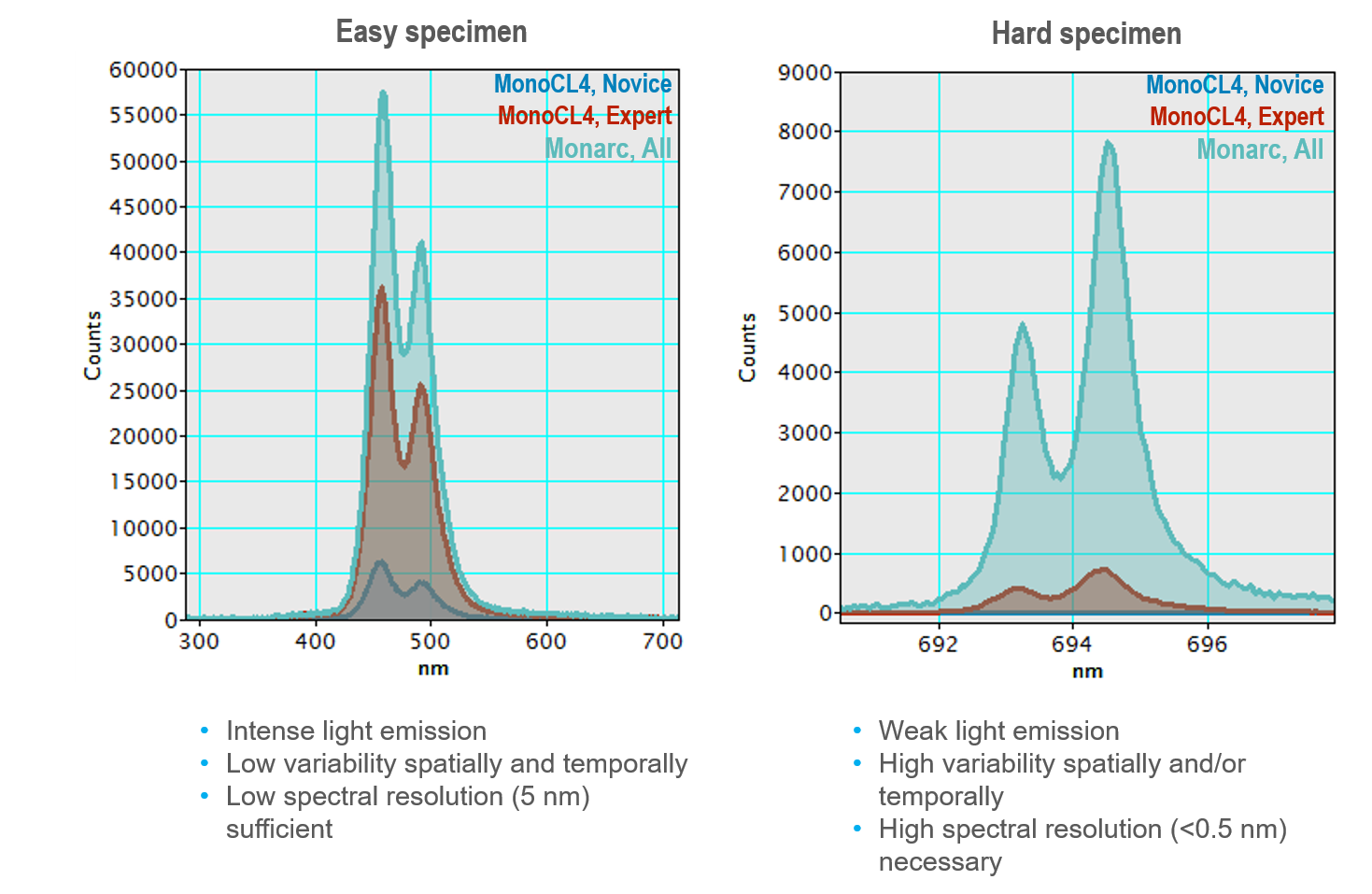
Insert the collection mirror
To begin, insert the Monarc's collection mirror into the SEM chamber. This occurs when you select the Insert radio button in the Monarc Setup palette in the Microscope tab on the left-hand side of the screen; the mirror will insert in under 10 s.
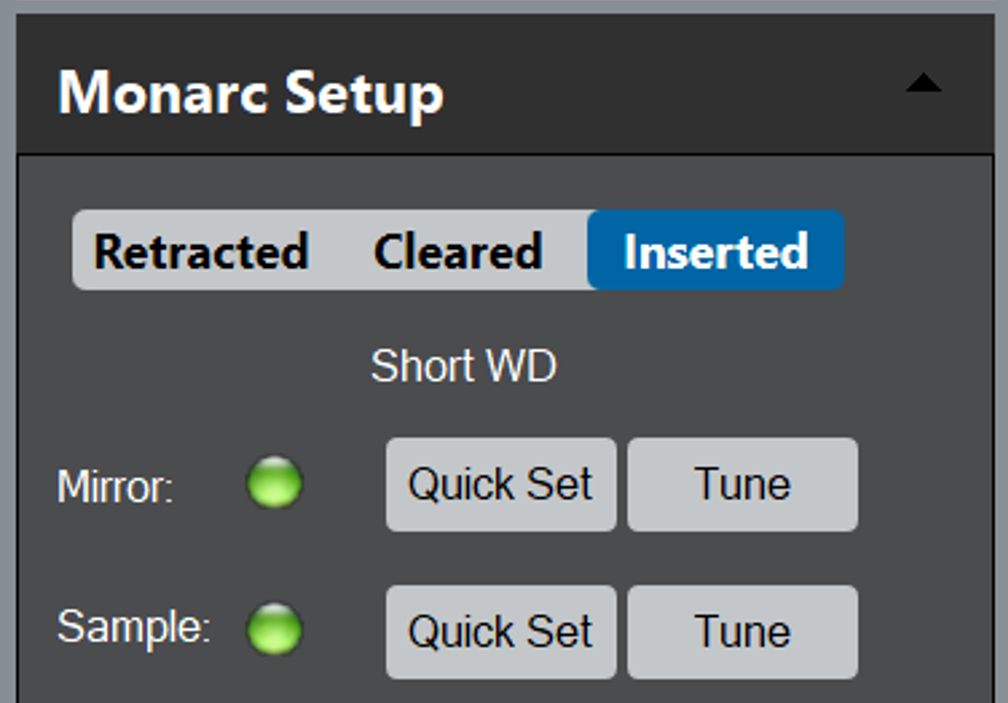 The mirror can be set in one of three pre-defined locations:
The mirror can be set in one of three pre-defined locations:
- Inserted – Sets the mirror under the pole piece in the cathodoluminescence (CL) operating location
- Retracted – Removes the mirror from the SEM chamber (up to 200 mm)
- Cleared – Partially retracts the mirror to provide a line of sight from the specimen to other detectors
When you insert the mirror at the start of a session, it returns to the last known good position for the current SEM settings.
Center the collection mirror
To align the CL system to the SEM's electron beam, localize the mirror focal point at the center of the SEM field of view. The precise location of this is difficult to determine as the focal point of the collection mirror cannot be observed directly.
Collection mirrors are designed with an aperture to allow the electron beam to reach the sample, and the focal point is located at the approximate center of the aperture. The exact location depends not only on the accuracy of the mirror itself but also on the alignment of the SEM's electron beam. When the SEM's accelerating voltage changes, the electron beam axis can shift, causing an apparent translation to the mirror's position and, if the optical axis of the SEM is not perpendicular, an apparent shift in the position of the focal point within the aperture.
The Monarc system includes a software routine to align the Monarc system to the electron beam axis of the SEM, tracking the settings of the SEM to alert the user when the mirror position may need to be reset.
Two ways of automatically positioning the mirror are available within the software:
- QuickSet – Returns the system to a previously good alignment for that SEM setting
- Tune – Forces the system to revalidate the alignment
The tuning procedure can take a few minutes but need only be applied infrequently during a session. For advanced users, the user may manually position the mirror and store the new coordinates.
Setting the sample at the correct position
For the CL system to operate efficiently, the sample must be set to the focal point of the collection mirror by adjusting the SEM stage location (Z-axis). The Monarc system includes automated alignment routines to optimize the sensitivity of the system uses the Sample alignment in the Monarc Setup palette:
- QuickSet – Returns the system to a previously good alignment for that SEM setting
- Tune – Forces the system to revalidate the alignment
The tuning procedure can take several minutes but need only be applied infrequently during a session.
Tracking the alignment status
The Monarc system tracks the state of the Mirror and Sample alignments, indicating this to the user by a traffic light system:
- Green – Indicates that the system is aligned
- Orange – The system has changed from the known-aligned condition, and alignment may need updating
- Red – No alignment has been performed
Ready to go…
When all components are aligned optimally, the light reflected from the collection mirror forms a collimated beam bundle that is free space coupled to the optical components downstream. The alignment of the downstream optical components is optimized for a collimated beam. No user alignment of the optics is required. For power users, manual control of the mirror position and stored QuickSet locations are available through the setup icon in the Monarc Setup palette.
Alignment for MonoCL and ChromaCL
Insert the collection mirror
To use the MonoCL™ or ChromaCL™ systems, insert the collection mirror into the scanning electron microscope (SEM) chamber manually:
-
Ensure it is safe to insert the collection mirror; the sample should be at a safe working distance, and no other detector should occupy the space needed for the collection mirror.
-
Set the SEM to a magnification of ~100x.
-
While viewing a secondary electron image, slowly insert the collection mirror so that its electron beam aperture appears central in the image.
Set the sample at the correct working distance
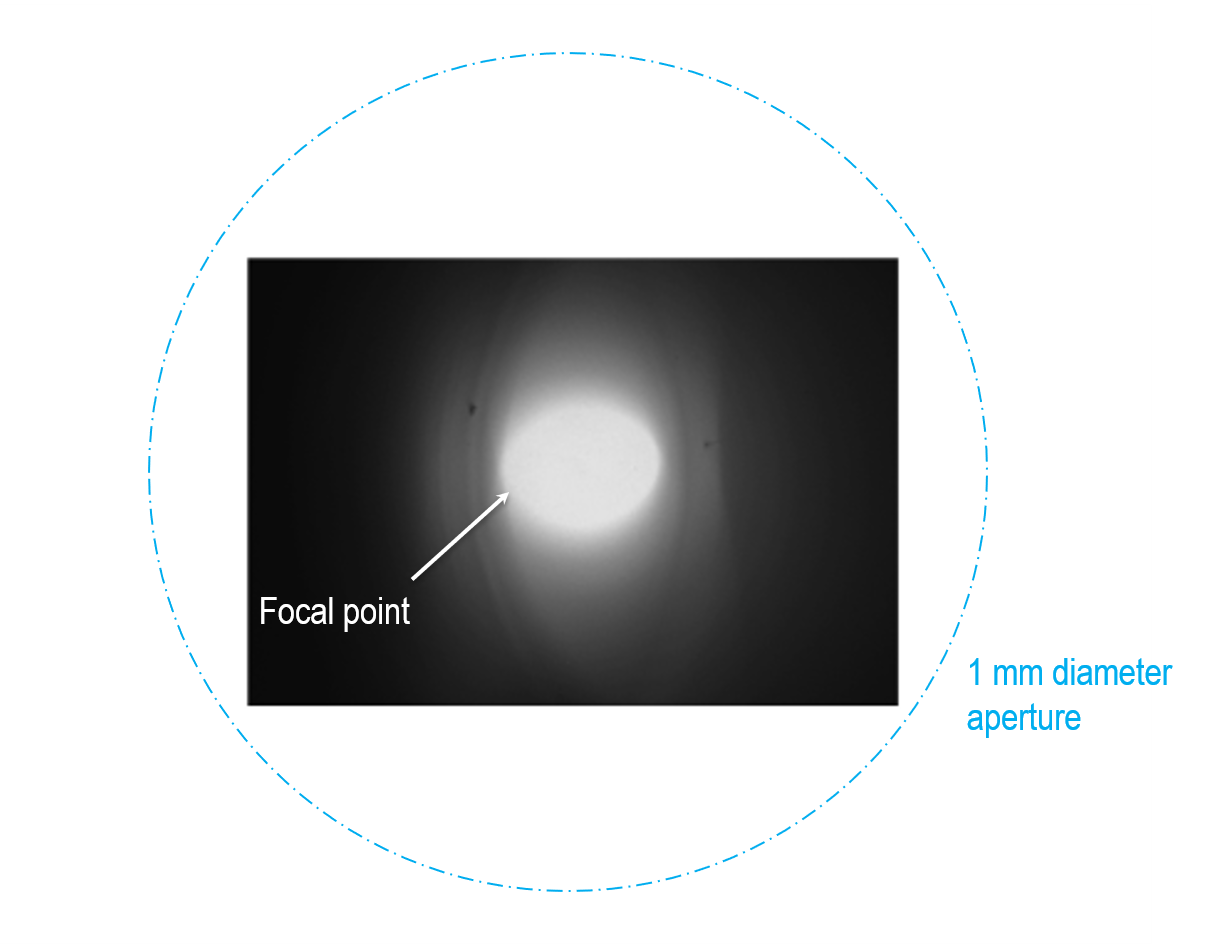 For the cathodoluminescence (CL) system to operate efficiently, adjust the SEM stage location (Z-axis) so the sample is set to the focal point of the collection mirror.
For the cathodoluminescence (CL) system to operate efficiently, adjust the SEM stage location (Z-axis) so the sample is set to the focal point of the collection mirror.
- MonoCL and ChromaCL systems – Refer to the user guide to manually perform this operation.
- Systems using the standard 10 mm tall collection mirror – The optimum distance is 0.95 – 1.05 mm below the bottom surface of the mirror. It may require fine adjustment to optimize the position based on the feedback from the CL signal.
The image shows the optimum settings when observing a clearly defined optical focus (hot spot or sweet spot). Note that the focus spot appears more like a crescent when the sample is not at the focal position.
Center the collection mirror
To align the CL system to the SEM's electron beam, locate the mirror focal point at the center of the SEM field of view. The precise location of this can be challenging to determine and track as you cannot directly observe the focal point of the collection mirror. However, you may use the hot spot (see above) and adjust the mirror's position (in the x- and y-axis) to align the hot spot to the center electron beam scan (center of the image). Note that using an electronic image shift will cause an apparent shift in the mirror position. This is useful for fine alignment of the collection mirror but should not be used during CL analysis in case of inadvertent misalignment of the CL and SEM systems.
Ready to go…
When all components are optimally aligned, the light reflected from the collection mirror forms a collimated beam bundle that is free space coupled to the optical components downstream. The alignment of the downstream optical components is optimal for a collimated beam. No user alignment of the optics is required.
Alignment for Vulcan
To collect the cathodoluminescence (CL) emitted from a sample, high numerical aperture (NA) mirrors are positioned above and below the specimen. Each mirror contains a small aperture that allows the primary electron beam to excite the specimen and for transmitted electrons to escape. Photons emitted from within a focal point of the collection mirrors are reflected and focused onto optical fibers that carry the signal out of the transmission electron microscope (TEM) column to analysis instrumentation.
A screw ring clamps the sample (3 mm diameter grid) into a small cradle to ensure it achieves good thermal contact.
The cathodoluminescence collection mirrors
The CL collection mirrors are manufactured to a precise mathematical form and are ellipsoidal. Ellipses are defined mathematical shapes with two focal points: one at the sample region of interest and the other at the optical fiber facet. The alignment of the two mirrors ensures each focus is co-aligned to be at the sample's region of interest. The light emitted from the mirror's focal point on the specimen is coupled very efficiently into the optical fibers.
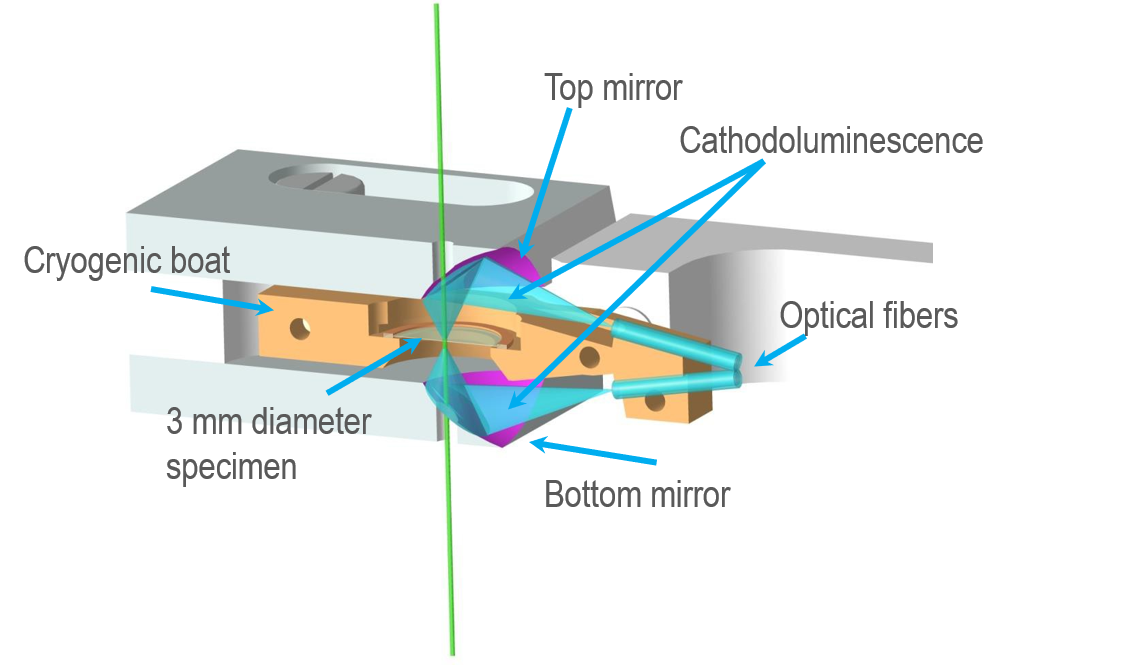
You cannot adjust the CL collection mirrors to optimize the position at which light is collected efficiently from a sample because it degrades light coupling to the optical fibers. The only way to achieve this is by moving the specimen grid within the specimen cradle so that the region of interest coincides with the region from which CL is collected efficiently. An optical microscope and lightbox are available so that you can inspect this during the sample insertion into the sample cradle.
It is important to manufacture specimens so that the thin region of the specimen is approximately centered on the 3 mm grid. For thick samples or a non-standard 3 mm copper grid (e.g., silicon nitride membranes supported on silicon), it is essential to position the sample's region of interest within the focal depth of the system since there is a limited focal depth (z-direction). The focal plane of the mirrors is designed to be the face on which a thin specimen sits. Ensure that the orientation of thick specimens is such that the region of interest is placed against the bottom of the specimen cup. See Figure below.
